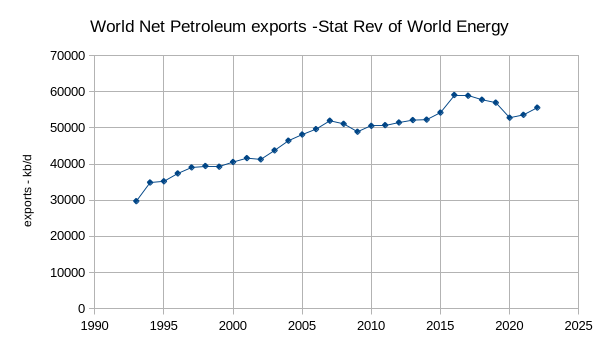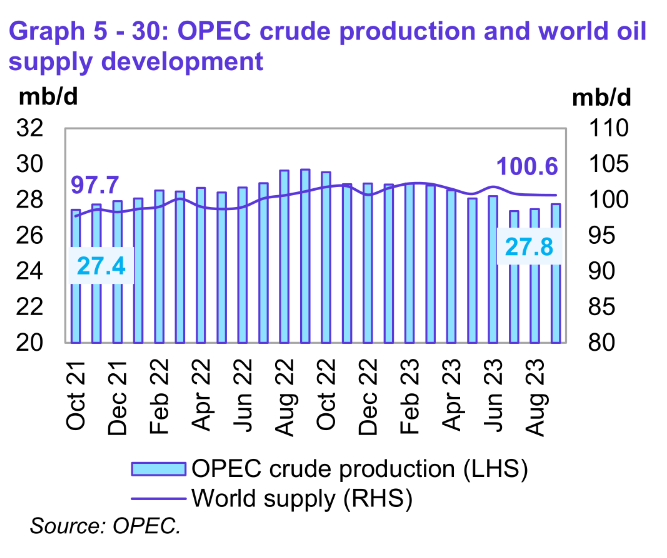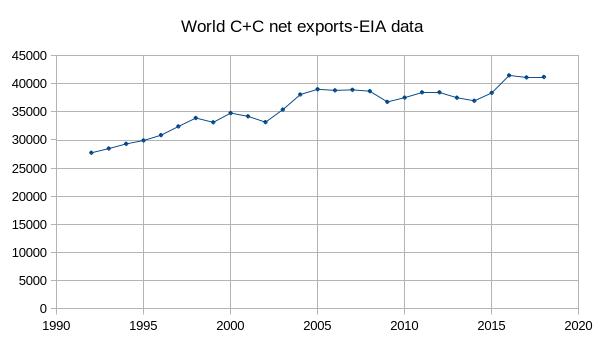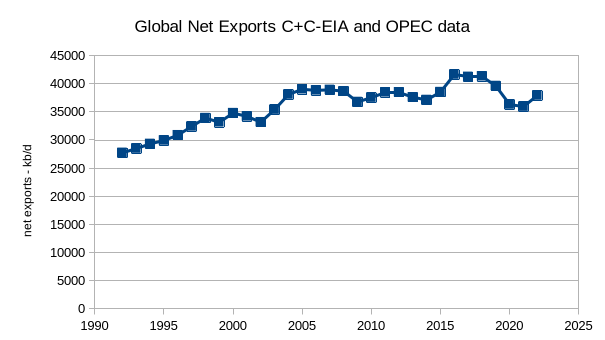His comment with the critique is found
here. I quote this graph from it:
1) My answer to Dennis' critique, posted on the "Peak Oil Barrel" blog:
"Dennis: As you may know, I build upon Jeffrey J. Browns calculations. I wonder how his numbers can be so different from the numbers of “Statistical Review of World Energy". According to Brown, global net oil exports peaked in 2005, and was at about 30 mbd in 2021 (and this is not only ANE oil, i.e. global net oil exports minus China and India’s net oil imports). According to your graph above, global net oil exports peaked in 2016-2017, and was at 51-52 mbd in 2020-2021, and then rose to 55 mbd in 2022-2023. I don’t understand how the differences can be so great, and I trust Brown more than an energy institute (for example IEA and EIA have not won my trust, not the least). Brown is the one who have the most mathematical expertise in the field, of all involved. But I will calculate a scenario based on your data, anyway. I will link to that later on. I will also add that I have confronted many different sets of data in this field, all differing wildly, so I’m used to the confusion. But thank you for your answer, it gave me something to work on."
Dennis' answer to this comment of mine:
"Lars,
J Brown may be doing crude only estimates. Not sure."
My answer:
"Dennis, I think you're right (if you also add condensates), because the numbers of "Statistical Review of World Energy" are about 25 mbd higher than Brown's numbers, which is exactly the difference between "crude+condensate" and "All Liquids" in overall global oil production numbers (and now I don't mean oil exports). I actually figured it out before I read your comment.
I think, by the way, that Brown is justified in his way of counting only "crude+condensate" when calculating oil exports, because we cannot really count on the unconventionals in our economy, if we seek sustainability, we cannot rely on them for a very long time to come, because they are so very expensive, and increasingly so, exponentially.
But your answer in some way confirmed my calculations, because I have indeed said in my book that Brown counted only crude+condensate, if I remember it correctly."
2) Now I will calculate the end of global net oil exports based upon the data of the "Statistical Review of World Energy" (a rewrite of this blogpost of mine):
"Preliminary data indicates that global liquids production in September was 0.1 Mb/d less than last month and averaged 100.6 Mb/d."
My comment: So global oil production fell by 100 000 barrels in one month, in August-September 2023. If this decline pace continues, it means 1,2 million barrels per day lost in one year, which is a decline rate of 1,2 % per year. Expect this decline rate to continue, and at last to begin to accelerate in the coming years, as the bell curve does in the "
Hubbert curve":
We probably reached the post-pandemic "All Liquids" oil peak in February 2023, at 101,5 mbd (1). See the following graph from Coyne's blogpost above:
If we take a very conservative, linear approach, and project a global oil production decline of 1,2% upon the future, fifteen, twenty years from now, then the decline of global net oil exports ("GNE") is at least the double of that (2), i.e. a 2,4 % yearly decline, which is 2,4 mbd lost per year (if we fix the amount of decline, because in percentage declines the amount of decline slows down with time, which it doesn't do in our case), which gives us almost 23 years of GNE if we begin with 55 mbd of GNE, which brings us to the year 2046 (about the time when our conventional oil reserves are used up, according to systems ecologist Charles A.S. Hall's calculations, His end point was 2047). Observe that I have not taken into account that the real decline of both global oil production and global net oil exports is exponential (it's a mathematical certainty, according to professional licensed oil geologist Jeffrey J. Brown), i.e. have an accelerated rate of decline, goes faster and faster (I use the term "exponential decline" to mean that in this blogpost). With that in mind, the end of GNE could very well happen well before 2046, which harmonizes with the thesis in my book on the end of global net oil exports. It could happen already in 2039-2042, which must be the
absolute upper limit in our calculations, for "All Liquids" exports. So this is only 16-19 years into the future.
If we then go to the decline of "ANE" ("Available Net Exports"), which is "GNE" ("Global Net Exports", the totality of global net oil exports) less the Chindia (China and India) region’s combined net oil imports, then the decline goes a lot faster, by at least 3 % per year, conservatively estimated. So 3 % of global oil production is ~3 mbd. We have 55 mbd of GNE left, at most. This give us only about 18 years of "ANE oil". And this brings us to 2041.
Add then the exponential factor, and we are easily at 2034-2037.
This, 2034-2037, is pretty much the best case scenario for the end of "All Liquids" global net oil exports, and is based on the results of "Statistical Review of World Energy's" global net oil export calculations.
3) Calculating with EIA's data
There are many data sets about global net oil exports out there. See how EIA calculates the global net crude+condensate oil exports from 1992-2018:
(Maybe EIA is double counting oil exports, as is hinted at in
this comment by "Hickory"? This is very easily done)
So according to EIA we were at about 41 mbd of global net crude+condensate oil exports in 2018, not 35-36, which Brown would have it at, I think. How many years of "ANE oil" would that give us, if we calculate that we have about 41 mbd now, which is a conservative estimate? 41 mbd divided by 4 (see the footnote 2) mbd gives us about 10 years. It brings us to the beginning of the year 2034. Remember that this is a linear scenario. Add then the exponential factor, and we are easily at 2027-2030, in about the area where Brown and I have ended up. This is strange, that beginning with very much higher numbers, gives us so similar results. Even beginning with the 55 mbd in the "All Liquids scenario" doesn't buy us many years, only a few, relative to Brown's and my scenarios. This should alarm everybody. How many years are three years actually? It's nothing in the grand scheme of things, and passes by very fast, at least for those who are 40 +.
4) Calculating with EIA+OPEC data
See how EIA and OPEC together calculates the global net crude+condensate oil exports from 1992-2022 or 2023:
According to this chart we reached peak global net oil exports, crude+condensate, in 2018, at 41-42 mbd, and then they have declined since about 2018. Now we are at 38 mbd, and the decline so far has averaged amost one mbd per year.
How many years of "ANE oil" would that give us, if we calculate that we have about 38 mbd now, which is a conservative estimate? 38 mbd divided by 4 (see the footnote 2) mbd gives us about 9,5 years. It brings us to the year 2033, almost exactly the year Jeffrey Brown predicted would be the end of "ANE oil". And this is in a linear scenario. Add then the exponential factor, and we are easily at 2026-2029, in about the area where I have ended up in my book.
(1) "World oil supply leapt 830 kb/d in February to 101.5 mb/d as the US and Canada rebounded strongly from winter storms and other outages." (From the website "Oil Market Report - March 2023). If we were at 100,6 in September this year, it's a decline of 0,9 mbd in 7 months, which translates to an average decline pace of ~1,54 mbd in a year, i.e. 1,54 %. This makes my calculations in this blogpost very conservative, because I calculate with a 1,2 % yearly decline, plus the fact that it is a linear decline, and that the decline amount is fixed. If we use the 1,54 % yearly decline, with a fixed amount of decline every year (otherwise the amount of decline would slightly decrease with time, which it does not do in our scenario), then the decline of global net oil exports ("GNE") is at at least 3,08 mbd per year in a linear scenario with a fixed amount, and the decline of "ANE" ("Available Net Exports", which is "GNE" less the China and India region’s combined net oil imports) is at least 3,3-3,6 mbd per year in a similar scenario. How many years of "ANE oil" does this give us? Answer: only 16,6 years if we begin with 55 mbd of global net oil exports, and with 3,3 mbd of "ANE oil" lost every year, linearly. 16,6 years into the future brings us to 2040. If we begin with 55 mbd of global net oil exports, and with 3,6 mbd of "ANE oil" lost every year, linearly, we get only about 15,3 years, which brings us to 2039. Observe that this is a linear approach, and that in reality the decline is exponential, i.e. an accelerated rate of decline (this is a thought experiment). I use the term "exponential decline" to mean that in this blogpost. Add then the exponential factor, and we are easily at 2032-2034 as the end of "ANE oil", which pretty much confirms Jeffrey J. Brown's calculations. But observe that Brown's calculations counted only "crude+condensate", i.e. conventional oil.
But observe also that the decline of global net oil exports is gradual, it does not just suddenly end abruptly. So when do we have way too little oil exports in this scenario (so little that society collapses. This is what really matters here), especially too little diesel exports? It may happen already during the years 2027-2033, which makes the argument in my book on the end of global net oil exports relevant anyway, even if I was too radical in my calculations, relevant as a warning for a time of too little diesel exports, an appeal to ration the remaining diesel exports, adopting the precautionary principle.
(2) In this article on "The Energy Bulletin" from October 18, 2010, Jeffrey J. Brown and Dr. Samuel Foucher calculated the decline rate of oil production in the North Sea between 1999 to 2009 to be at 4.8%/year. During the same time oil exports from the area fell by more than double the percentage, yes almost a triple. Brown and Foucher says:
"Note that the net export decline rate exceeded the production decline rate, starting out in double digits, at 12.8%/year, and accelerated to close to 30%/year at the end of the net export decline period."
So my estimate that the decline rate of oil exports is at least 2,4 % right now, is conservative and minimalist, at solid ground, I think.
If we shall calculate the end of "ANE" global net oil exports with an almost tripling of the 1,2 % of overall global oil production decline, then we have to calculate with, say, an at least 3,2 % decline of "GNE oil", and about a 4 % decline of "ANE oil" *. 4 % of global oil production is about 4 mbd (which, subtracted yearly from our amount of oil exports, translates to a loss of as much as 333 000 mbd "ANE oil" every month). How many years will a yearly decline of 4 mbd "ANE oil" give us? 55 divided by 4 gives us about 13,75 years. 13,75 years from now we are in 2038. Add then the exponential factor, and we are easily in the years 2032-2034.
If we then account for the almost one million barrel that has been lost in overall global oil production since February 2023, and which is not accounted for in Statistical Review of World Energy's graph above, then we have to subtract almost the quadruple amount from oil exports (because "ANE oil" declines with almost the quadruple rate of overall global oil production, compare the 1,2 % with the 4 % above), which is about at least 3,4 mbd. So 55 mbd minus 3,4 mbd is about 51,6 mbd. How many years will a yearly decline of 4 mbd "ANE oil" give us if we start with 51,6 mbd? Answer: 12,9 years. This brings us to the end of the year 2036. Add then the exponential factor, and we are easily in the 2030-2033 range, which confirms Jeffrey J. Brown's calculations. But Brown calculated oil exports with only "crude+condensate", and here we are calculating the "All Liquids" oil exports. So the end of "All Liquids" oil exports could be in the 2030-2033 range, while the end of conventional, "crude+condensate" oil exports, could very well be around 2027, plus or minus a few years, which was what I predicted in my book. So, again, my numerous calculations in my book are confirmed.
* I have in my book on oil exports calculated that the end of "ANE oil" comes about two years before the end of "GNE oil" (it has a much steeper decline curve). If our time window is ten years, then two years of that is 20 %. 4 mbd is almost 20 % more than 3,2 mbd (4 mbd is 0,8 mbd more than 3,2 mbd. 5 x 0,8 is 4. 20 % of 4 is 0,8).
For confirmation, see this article from 2012 by Jeffrey J. Brown, where he says:
"Our database shows that GNE fell from about 46 mbpd (million barrels per day) in 2005 to about 44 mbpd in 2011."
"We define available net exports (or ANE) as GNE less China and India’s combined net oil imports. ANE fell from 40 mbpd in 2005 to 35 mbpd in 2011 as the developing countries, led by China and India, consumed an increasing share of a declining volume of GNE."
So already from the beginning, ANE fell by a whopping 5 mbd in six years, while GNE fell with only 2 mbd in six years. A decline of 5 is more than double the decline rate of 2.
2 mbd in six years is a decline of 4,3 % of the original 46 mbd of GNE, and is a yearly decline of 0,33 mbd per year or a 1,43 % yearly decline.
5 mbd in six years is a decline of 12,5 % of the original 40 mbd of ANE, and is a yearly decline of 1,2 mbd per year or a 3 % yearly decline.
As you can see, 3 % is more than 2 times as much as 1,43 %. So much faster the ANE declined in comparison with GNE, in the beginning, according to Jeffrey J. Brown's calculations.
4 mbd is not the double of 3,2 mbd, only 20 % more (see above). So my calculations are very conservative, leaving room for hope. If we would calculate that the end of "ANE oil" is 80 % sooner than what has been assumed of the end of "GNE oil", where would we land? 80 % of 2 years is 1,6. So the end of "ANE oil" would then come, not two years earlier than the end of "GNE oil", but at least three and a half year earlier, which would make the results of my calculations even more radical. The decline percentage of "ANE oil" would then be 2 X 3,2 %, which is 6,4 %, which, if I applied it on my calculations, would make the end of "ANE oil" come even sooner. Therefore my calculations here are conservative, but I stick with that, so I'm able to believe in my own calculations. Maybe Brown made some mistakes here, because it seems too radical. Just think about it, if we have 30 mbd of global net oil exports, crude+condensate, today **, then how many years of "ANE oil" do we have if the decline is by 6,4 % every year? With a linear approach, not even counting on an accelerated decline? Answer: only 4,6 years, in a linear scenario, which brings us to the year 2028. And with an exponential approach, we then arrive in 2024-2025. This reminds me of my calculations in my book on oil exports, and makes me understand why I arrived at so radical conclusions in it.
* * We were at 97,7 mbd "All Liquids" oil production in October 2021, when Jeffrey J. Brown made his statement about us having 30 mbd of global crude+condensate net oil export left. This makes it tricky. We had our post-pandemic peak in February 2023 at 101,5. This is 3,8 mbd more than in October 2021. It translates to about at most 3-4 mbd of global net oil export gains, in crude+condensate, because at the same time oil exports followed the decline trend from 2005, and declined even more, this was the underlying reality. So we maybe gained at least 6 mbd of "GNE oil", but lost at least 3 mbd to the natural decline. So, if we were at 30 mbd of "GNE oil" in October 2021, we were probably at mostly 33-34 mbd of "GNE oil" in February 2023. Since then overall oil production (All Liquids) has declined by 0,9 mbd, which translates to about 3-4 mbd less oil exports (because the pace of decline of "ANE oil" is almost quadruple the decline of overall global oil production, see what I have said about it above), so we land at about 30 mbd "GNE oil" today. This is difficult to calculate, so the reality may be more than or lesser than this amount.

![5 Hubbert's bell-shaped curve for time versus production of any exhaustible resources projection plot for the time interval 1850-2200 AC [7].](https://www.researchgate.net/profile/Neelu-Chouhan/publication/281206525/figure/fig3/AS:669141988020257@1536547290828/Hubberts-bell-shaped-curve-for-time-versus-production-of-any-exhaustible-resources.png)




